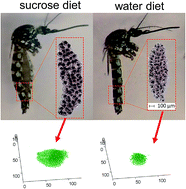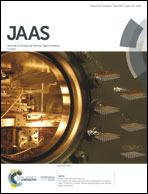Three dimensional secondary ion mass spectrometry imaging (3D-SIMS) of Aedes aegypti ovarian follicles†
Abstract
The mobilization of nutrient reserves into the ovaries of Aedes aegypti mosquitoes after sugar-feeding plays a vital role in the female's reproductive maturation. In the present work, three-dimensional secondary ion mass spectrometry imaging (3D-SIMS) was used to generate ultrahigh spatial resolution (∼1 μm) chemical maps and study the composition and spatial distribution of lipids at the single ovarian follicle level (∼100 μm in size). 3D-Mass Spectrometry Imaging (3D-MSI) allowed the identification of cellular types in the follicle (oocyte, nurse and follicular cells) using endogenous markers, and revealed that most of the triacyglycerides (TGs) were compartmentalized in the oocyte region. By comparing follicles from water-fed and sugar-fed females (n = 2), 3D-MSI-Time of Flight-SIMS showed that TGs were more abundant in ovarian follicles of sugar-fed females; despite relative sample reproducibility per feeding condition, more biological replicates will better support the trends observed. While the current 3D-MSI-TOF-SIMS does not permit MS/MS analysis of the lipid species, complementary LC-MS/MS analysis of the ovarian follicles aided tentative lipid assignments of the SIMS data. The combination of these MS approaches is giving us a first glimpse of the distribution of functionally relevant ovarian lipid molecules at the cellular level. These new tools can be used to investigate the roles of different lipids on follicle fitness and overall mosquito reproductive output.

- This article is part of the themed collection: SIMS for Biological Applications


 Please wait while we load your content...
Please wait while we load your content...
